Investigation of the possible causes of the Mayak satellite accident
Foreword
This article continues to publish the “State of the Mayak satellite in terms of research into the causes of satellite failure.
In short, we are based on:
- the finalization of a constructive-like model of “Mayak” to the flight state and the successful conduct of its vibrodynamic tests according to the program agreed with Roskosmos and used to allow “Mayak” to the launch vehicle,
- analysis of the known information about the state of the Mayak satellite, published information about the state of Mayak’s fellow travelers and the device of the upper stage (RB) Fregat,
we assume that “Mayak” and other failed satellites, put into orbit with an approximate apogee of 600 km, failed because of the decomposition products of hydrazine from one or several liquid thrusters (LRE MT) C5.221.00-0 used in the reactive control system of the upper stage (RB) “Fregat”.
')
The studies that led us to this conclusion and the analysis of alternative failure mechanisms are given in the article below.
Introduction
Mayak became the first Russian satellite created by the hands of enthusiasts and launched into orbit. The success of this project or failure will definitely affect the attitude to projects of this kind, both for space lovers and for the large state-owned space industry. In addition, the project was carried out through voluntary donations, the method of crowdfunding. Therefore, we decided to set out as openly as possible our research on the search and analysis of possible causes of equipment failure. The reason to deal with the reasons for the refusal is also the desire to protect other satellite builders, amateurs and professionals from repeating our mistakes. Well, to protect against errors, you first need to understand what they are.
Separately, I would like to note: this study does not in any way detract from the merits of enterprises of the domestic rocket and space industry. Moreover, as the head of the Mayak project and the author of this material, I have the deepest respect and gratitude to all the Russian cosmonautics workers who created the modernized Soyuz 2.1a launch vehicle and the wonderful Fregat upper stage, which ensured the launch into our orbit "Mayak" and another 72 small and large vehicles, thereby setting a new Russian record.
Chronology of events
May 30, 2016. The Moscow Polytech began assembling a flight copy of the Mayak satellite and its structurally similar dimensional-mass layout. Differences from the layout of the flight instance:
- there was no on-board computer,
- there was no onboard cable network,
- there were no limit switches controlling the unwinding of the roulettes.
- the battery was assembled from elements that did not pass preliminary screening tests,
- the solar reflector was placed inside the solar reflector container in a non-standard manner.
The remaining systems are regular.
June 15, 2016. Completed assembly of the flight copy of the “Beacon” and its overall mass layout.
June 20, 2016. Thermal vacuum tests of the “Beacon” flight copy with disclosure of the reflector frame in vacuum were successfully carried out.
June 25, 2016. A fitting and flight copy, and a layout in the layout of the transport-launch container of the company ECM . Both copies entered the container, but the spring force was not enough to push the copies out of the container. Both samples are sent for revision.
July 29, 2016. Successful fitting of the flight copy and the layout to the layout of the transport and launch container of the ECM company was carried out.
September 13, 2016. In NIIEM completed test vibrodynamic tests of the flight copy of “Mayak”. The test report indicating the absence of external defects and signed by the Deputy General Director of NIIEM for Quality S.P. Skorobogatovym, allowed to obtain admission to the Soyuz-2.1a rocket.
September 14, 2016. During the functional tests of “Mayak”, his refusal was revealed. The on-board electronics turned out to be without power; there was no voltage at the battery terminals.
September 15, 2016. The flight copy was disassembled, more than half of the contact welding points of the conductors between the battery cells were destroyed. When analyzing the causes of destruction, it was revealed that the cells had too high mobility inside the battery pack and when excited at their resonant frequency, the conductors between the cells collapsed. An identical battery was assembled and a small shaker was created, on which resonant frequencies were determined and experimentally, in laboratory conditions, the mechanism of destruction of welding joints was confirmed. The method of preventing the destruction of welding (see below) was tested on the same vibrostand; the method showed its suitability. The resonant frequency leading to the destruction of welding points or battery failure could not be identified. The battery cells were checked individually at the battery analyzer stand (no deviations were detected), and when assembled they were bonded with adhesive bonding to each other, to the boards and to the case of the battery pack using vacuum-resistant epoxy glue VK-9, the conductors between the cells were replaced with more flexible ones and duplicated Thus, each cell of the battery had a 4-fold reservation of contact) and also filled with a layer of VK-9. Vibrodynamic tests of the assembled battery were successfully carried out on a small vibration table.
September 18, 2016. Completed battery repair. The battery is charged. Flight copy assembled.
September 19, 2016. Passed a successful fitting and flight copy, and the layout of the layout of the transport and launch container company ECM.
September 22, 2016. A presentation of the Mayak satellite was held at the Moscow Polytechnic University.
March 23, 2017. Conducted a battery charge check. The charge was more than 95% of the nominal capacity; no imbalance of the elements was detected.
May 10, 2017. Passed a successful fitting and flight copy, and the layout of the flight transport and launch container company ECM. The transport container with the flight copy and mockup is sealed and handed over to “Glavkosmos” for shipment to Baikonur.
June 21, 2017. In the MIK of the site 31 of the Baikonur Cosmodrome, a successful integration of the Beacon flight copy into the ECM company flight-launch container was carried out. Conducted a battery charge check. The charge was more than 95% of the nominal capacity; no imbalance of the elements was detected. On the flight copy of the “Mayak”, located inside the transport and launch container of the ECM company, the control of the limit switches activation and the cyclogram of the on-board equipment operation was successfully carried out.
July 14, 2017. Lighthouse in orbit!
August 9, 2017. The lighthouse did not open, the search for causes.
August 29, 2017. Dauria’s satellites failed , one LEMUR 2 and one FLOCK 2K were in non-calculated orbits .
In fact, one of the eight “Lemurs” LEMUR 2 ARTFISCHER was in orbit with an apogee of 477 km, in which there are 47 “Flocks”, although there should have been 48, and one of the “Flocks” probably did not turn on and was in orbit with apogee of about 605 km, where the remaining seven "Lemurs" are located. There are 47 FLOCK 2K satellites in the NORAD catalog, while there should have been 48. All 47 are in orbit with an apogee of about 477 km. There are 8 LEMUR 2 satellites in the NORAD catalog, with 7 satellites in orbit with an apogee of about 605 km, and 1 satellite in an orbit with an apogee of about 477 km. It looks as if one “Lemur” and one “Flock” are reversed.
August 31, 2017. Quote from Lenta.ru . The head of the Glavkosmos launch programs, Vsevolod Kryuchkovsky, explained why several satellites, launched on July 14 by the Russian Soyuz-2.1a rocket, did not get in touch or ended up in an unplanned orbit. He told his version of what happened to the Space News publication. According to Kryuchkovsky, from all foreign customers, Glavkosmos received official confirmation of the successful separation of the satellites from the upper stage of the launch vehicle. The Roscosmos subsidiary also assured foreign partners that during the separation the rocket was operating normally.
Otherwise, the head of the launch programs of Glavkosmos assesses the situation with the satellites of Russian developers. “This is their first experience in the development of Kubsat,” he said. “Maybe something happened on the development side, either with components, or with ground stations.”
September 1, 2017. It turns out that at launch three more Cicero satellites of the American company GeoOptics and one Russian-Ecuadorian UTE-UESOR failed.
September 8, 2017. Refused 2 apparatus of the American company Astro Digital.
October 5, 2017. “Glavkosmos” returned the dimensional-mass layout of the “Mayak”. It was decided to modify the layout to the flight (identical to the running device) state and to test its strength under the action of loads from transportation and removal, while its battery is modified according to the technology of repair of the flight battery.
November 8, 2017 . The revision of the mass-produced “Mayak” mockup to the flight state has begun.
November 12, 2017. Completion of the final mass layout of the “Beacon” to the flying state has been completed. The battery is made on the same technology as the flight copy, by the same staff on the same equipment.
November 15, 2017. The testing of the “Mayak” mock-up was started according to the program of vibrodynamic test methods used for admission to the Soyuz-2.1a launch vehicle.
November 22, 2017. Successfully completed the test layout “Beacon”. There were no deviations in the work, all the systems after tests are working normally.
Total dry residue:
- By November 25, 2017 it was known about the failures of 10 cubesat out of 19, launched into orbit with a conditional apogee altitude of 600 km;
- The “Mayak” model, modified by the flight technology, has successfully passed vibrodynamic tests according to the program agreed with Roskosmos and used to allow the “Mayak” to launch vehicle.
Analysis of the probable causes of failure of “Mayak”
Conceptually, we can divide the probable causes of failure into internal and external. Internal depend on the state of the product itself, external - on the impact of external factors on the product.
First we analyze in detail the hypotheses about the refusal of “Mayak” for internal reasons, consider the possible measures to check them, then do the same for external reasons.
Analysis of the likely internal causes of failure of “Mayak”
Since the Mayak project team created the spacecraft for the first time, it is likely that it could have made mistakes in its development, design and production, which caused a failure in orbit.
Known facts to analyze:
- During vibrodynamic tests of the flight copy of the Mayak spacecraft, a power supply system failure was recorded, which did not affect the design integrity of the device, but resulted in the failure of all onboard equipment.
- The detected failure of the power supply system was eliminated, technological vibrodynamic tests were carried out, demonstrating the strength of the design of the repaired battery.
- During the thermal vacuum (TFI) and vibrodynamic (VDI) tests of the flight instance of the Mayak spacecraft, no other failures were found.
- The overall mass layout of the “Beacon” was refined to flight condition. The battery is made on the same technology as the flight copy, by the same staff on the same equipment.
- Successful vibrodynamic tests were carried out according to the program-method used for admission to the Soyuz-2.1a launch vehicle.
Accepted hypotheses
Hypothesis №1. In real flight, the same system fails as in the tests.
On the spacecraft, even on such a simple as “Mayak”, a lot of different onboard systems.
In our case it is:
- Basic structure,
- on-board electronics,
- power supply system
- onboard cable network,
- reactor engine
- solar reflector
- solar reflector opening system.
During ground-based experimental testing, when loads were applied to a spacecraft during transportation to Baikonur, via Baikonur, only one system failed during flight on a launch vehicle, detachment from the upper stage and orbital flight, all the others worked normally. This allows us to conclude that in real flight, under the action of the same loads, the most likely failure of the same system.
Hypothesis №2. In real flight on July 14, 2017, no more than the loads that were subjected to vibrodynamic tests acted.
This statement can be confirmed by the fact that most of the spacecraft did not show signs of destruction during orbital flight.
Strength study
To test the hypotheses put forward, it was necessary to conduct repeated tests. Since thermal vacuum tests (TTIs) were carried out on the flight specimen and no problems were found, it was decided not to perform repeated TTIs.
The purpose of the research is to experimentally test the strength of a repaired “Mayak” rechargeable battery, similar to that installed on a flight copy, when subjected to vibrations, shocks and overloads, similar to those acting on a spacecraft during transportation to Baikonur, to Baikonur, while flying on a booster rocket and separating from the booster unit, while additionally verify the performance of other systems of the device.
Preparation of the test object
The overall mass layout of the “Beacon”, as mentioned above, differed from the flight instance in the following:
- there was no on-board computer,
- there was no onboard cable network,
- there were no limit switches controlling the unwinding of the roulettes.
- the battery was assembled from elements that did not pass preliminary screening tests,
- the solar reflector was placed inside the solar reflector container in a non-standard manner.
As for the rest, including the operability of the solar reflector deployment system, the layout corresponded to the flight instance.
Therefore, to carry out a full-fledged experiment that confirms or disproves the performance of Mayak after it was placed in orbit, it was necessary to install an on-board computer, install an onboard cable network, and assemble a rechargeable battery using flight technology. The solar reflector inside its container was placed abnormally, since it did not affect the verification of the disclosure process.
Before testing, the model worked as follows.
Testing
The tests were conducted in the JSC "NPO IT" at the address 141074, the Russian Federation, Moscow region, Korolev, ul. Pionerskaya, house 2. This company, by the way, is part of Roscosmos.
The tests were carried out according to our already published program “Spacecraft“ Mayak ”. The program and methods of testing for static and vibrodynamic strength of the Mayak-VDI-PM-1 ” , according to which we tested the flight instance of“ Mayak ”and received an admission to the launch vehicle. From the program it is clear that its different sections imitate the loads acting on the apparatus at various stages of its life cycle.
Transportation apparatus to Baikonur and Baikonur, blows up to 5 g.
Static overloads reaching 10 g.
Random vibrations with rms values up to 10 g.
Impacts in the separation of the launch vehicle units with an amplitude of up to 40 g
Here the strikes were prepared for so long and so quickly passed that I did not have time to shoot them. But the measurement of the voltage level on the battery did. Such measurements were carried out after each type of test and did not reveal deviations in the voltage level on the battery.
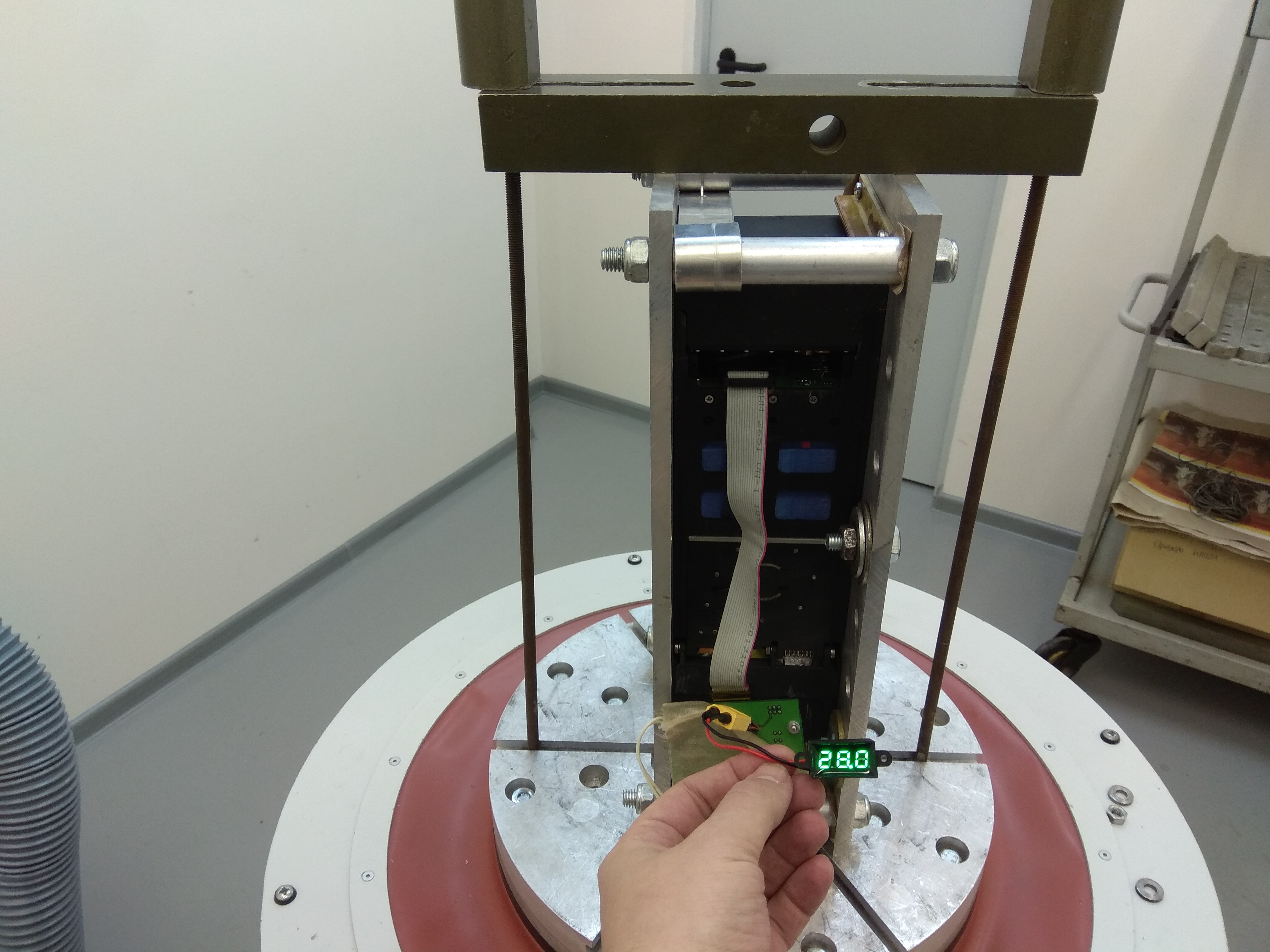
And, finally, the separation of the “Beacon” from the upper stage, hit up to 150 g!
I must say that this is an obvious reinsurance, since “Mayak” was pushed out of the container with a soft spring at a speed of about 1 m / s.
It is worth adding that before and after the application of loads, measurements of the amplitude-frequency characteristic (AFC) of the layout with the equipment were carried out. In these measurements, the logic is as follows: if something inside the structure fell off or broke, then it will react differently to vibrations, old resonances change, or new ones will arise.
In our case, nothing happened.
And finally, the video disclosure of the layout after all the tests.
Test results
Measuring the voltage level on the battery, measuring the frequency response before and after testing, and, most importantly, checking the disclosure of the layout before and after testing, allow you to state the following:
- The voltage on the battery during the tests was 27.9-28.0 V.
- Vibrodynamic tests did not affect the performance of on-board electronics.
- The frequency response during the tests has not changed.
- Mechanical systems have not undergone changes - the layout is revealed both before and after the tests.
Conclusions from the analysis of internal causes of failure
Thus, it can be argued that the layout of the “Mayak”, modified to the flying state according to the technology used in the repair of the flight copy, has successfully passed vibrodynamic tests.
We could not find the internal reasons for the failure of “Mayak”. Next, we consider external influences that could cause failure.
Analysis of the probable external causes of failure of “Mayak”
Known facts for analysis
All spacecraft scheduled for launch into orbits are separated from the Fregat upper stage [ 1 ]. In their composition Kubsaty:
- 1U "Ecuador UTE-UZGU" - 1 pc,
- 3U - NanoACE - 1 pcs., “Mayak” - 1 pcs., “Iskra-MAI-85” - 1 pcs., LEMUR 2 - 8 pcs.,
- 6U - CICERO - 3 pcs., Corvus-BC - 2 pcs., MKA-N - 2 pcs.
10 Kubsat out of 19 refused, put out into orbit with an approximate apogee of 600 km. In addition, the LEMUR 2 ARTFISCHER cubs and one of the FLOCK 2K were in non-calculated orbits [ 2 ].
The Kursk device "Ecuador UTE-UZGU", named in the article [ 2 ] UTE-UESOR, from July 15 to July 30 transmitted telemetry data indicating low battery power. After July 30, sporadic signals were received that could not be decoded [ 2 ].
The abnormal situation took place only at the stage of separating the Kubsat in orbit with an approximate apogee of 600 km, as it is known about the normal operation of the Canopus-V-IC spacecraft [ 3 ], separated in an orbit with the conditional apogee of 517 km, microsatellites Flying Laptop [ 4 ], TechnoSat [ 5 ], WNISAT-1R [ 6 ], NORSAT-1, NORSAT-2 [ 7 ] separated in an orbit with an approximate apogee of 600 km, and 47 cubes of the Flock-2k type [ 8 ] separated in an orbit with an approximate apogee 475 km. “Kanopus-VK-IK” and five microsatellites successfully separated before the separation of dissimilar cubsats, 47 Flock-2k separated after dissimilar cubsat. Devices separated before and after dissimilar cubsat function normally.
Preliminary analysis of external causes of failure
The purpose of the study of external causes of failure is to put forward versions of the accident that best explain the known facts and are able to give predictions about the fate of other spacecraft launched into orbit on July 14, 2017.
In this regard, the version that the satellites were deliberately spoiled by pests, damned, replaced with bricks and other unscientific hypotheses that could not be verified, were not considered.
The falsification of the advanced versions of the accident is based on the subsequent verification of their predictions.
Accepted hypotheses
Hypothesis №1. Removal of all the spacecraft to the specified orbits proceeded normally, an abnormal situation occurred only after the release of the cube from the container.
In other words, the loads acting on the spacecraft during their joint flight on a launch vehicle and on the upper stage did not lead to satellite failure and by the time of separation the satellites were operational. The normal operation of spacecraft separated before and after dissimilar cubsat speaks in favor of this hypothesis.
Hypothesis №2. The failure of the Kubsat, put into orbit with an approximate apogee of 600 km, is caused by the same reason.
This hypothesis is difficult to verify by numerical calculations, since estimates of the probabilities of the failure-free operation of the failed machines are unknown, but it can be assumed that satellites created by different teams in different countries from different components with a low probability simultaneously failed due to their internal causes.
Hypothesis №3. Failure of Kubsat caused by external influence.
If the reason for the failure of the Kubsat is the same, then it is logical to assume that this reason is external to the devices themselves.Devices of different manufacturers, having different designs and on-board systems, failed; they had only in common that they were made in the same Cubesat format and flew on the same rocket. There is no reason to assume that the format of the satellites, their geometrical dimensions and limitations on their design, caused them to fail, so it can be assumed that the cause of the failure lies in their joint flight, first on the launch vehicle and then on the upper stage.
Taking hypothesis # 1 into account, we believe that the process of their separation from the upper stage and the subsequent free flight served as the reason for the refusal.
Possible types of external influences
Consider the possible types of external influence on the cubsat under the division:
- Mechanical impact. Vibrations, shocks, overloads, limited movement.
- Gas-hydrodynamic effect. Jets of gas and liquids.
- Heat exposure. Intense infrared radiation that causes heating of the irradiated surface.
- Electromagnetic exposure. Radiation of radio waves.
The list of impacts is formulated on the basis of the study of Chapter 3. ENVIRONMENTAL CONDITIONS of the Soyuz User's manual [ 9 ] document, which describes, among other things, the effects on a spacecraft displayed on a Soyuz-2 rocket with an overclocking Fregat unit. The list is refined using the hypotheses put forward.
Possible types of external influences and their consequences for cubes
We describe in more detail the possible types of effects on cubsats, based on their possible types.
1. Damage as a result of collisions between devices when exiting containers The
implemented cyclogram of separation of the spacecraft from the upper stage was not published, but there were no collisions of satellites during the launch of other launches, including the simultaneous elimination of a larger number of cube.
For example, you can study the video mass discharge of cubes from the Indian PH PSLV-C37, which on February 15, 2017 successfully put 104 spacecraft into orbit.
The probability of mutual collisions between ten cubesat at once is extremely small. In addition, the rate of release of the cube from the container is about 1 m / s [ 10 ]. Strikes at such speeds do not lead to complete failure of the apparatus. In addition, the number of objects in orbit corresponds to the calculated one, that is, no satellite debris is observed. This type of accident can be considered unlikely and excluded from further consideration.
2. Damage by blows of the separated parts of the upper stage
As mentioned earlier, the number of objects in orbit corresponds to the calculated, no debris is observed. In addition, it seems unlikely that the upper stage would be able to perform maneuvers to change the orbit with massive details separated from it that could damage the cussets. This type of accident can be considered unlikely and excluded from further consideration.
3. Damage by blows of detached parts of launch canisters.
Similar to the previous version, this type of accident can be considered unlikely and excluded from further consideration.
4. Damage to a jet of compressed helium from balloon balloons of pressurization tanks
According to the scheme of the propulsion system of the reactive control system (RSU), given in the Bulletin of the NPO. Lavochkina, №1 from 2014 [ 11], the balloon is in one system.
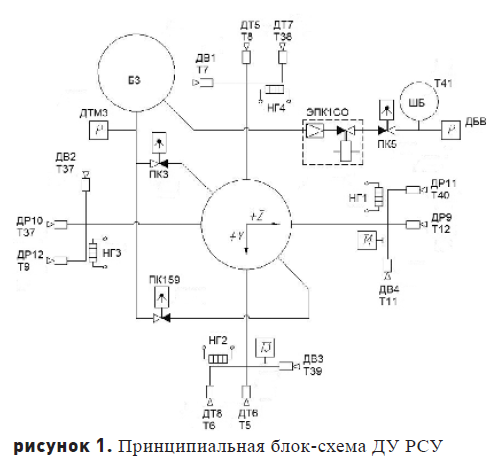
In the event of damage to it, the RB “Frigate” would not be able to continue the controlled flight, respectively, would not be able to withdraw the Flock 2K vehicles and perform a flooding maneuver. Conducting similar reasoning for tanks marching propulsion system, you can eliminate the failure and the ball-cylinders designed for pressurizing fuel tanks and oxidizer. Thus, this type of accident can be considered unlikely and excluded from further consideration.
5. Damage to the jet stream during normal operation of the propulsion system of the jet control system.
According to Vestnik NPO im. Lavochkina, №1 from 2014 [ 11], the structure of the propulsion system of the reactive control system (DU RSU) includes 12 of the same type of liquid rocket thrusters (LRE MT) of the type C5.221.00-0, arranged in four blocks, see figure.
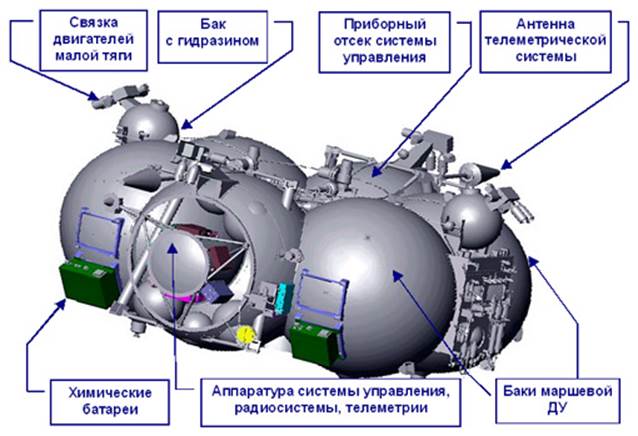
The scheme of the RB “Frigate” without the installed mast of and the payload.
At the launch of July 14, 2017, the upper stage with the installed and containers of cube arrays looked as follows.
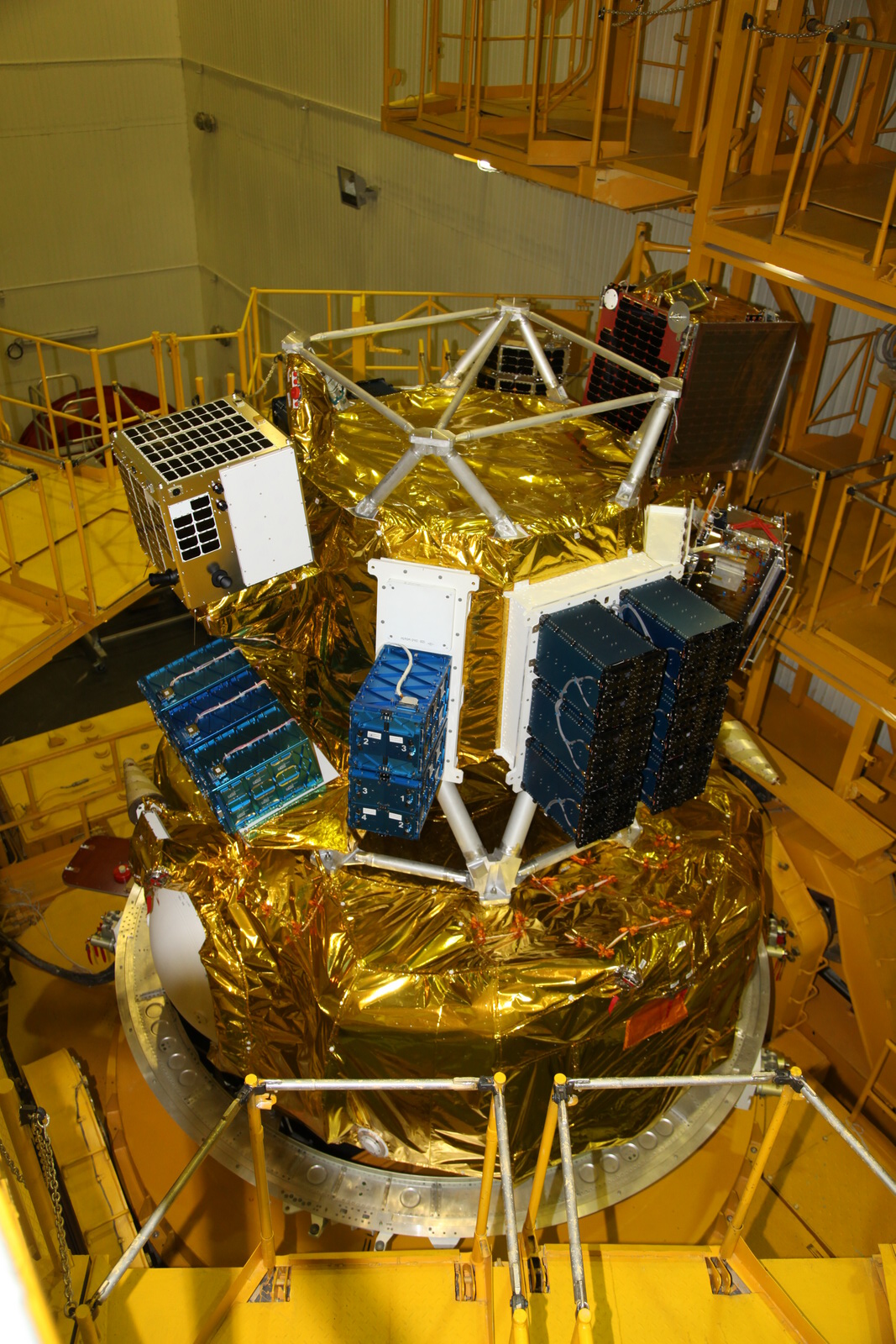
Picture from the page www.roscosmos.ru/23733
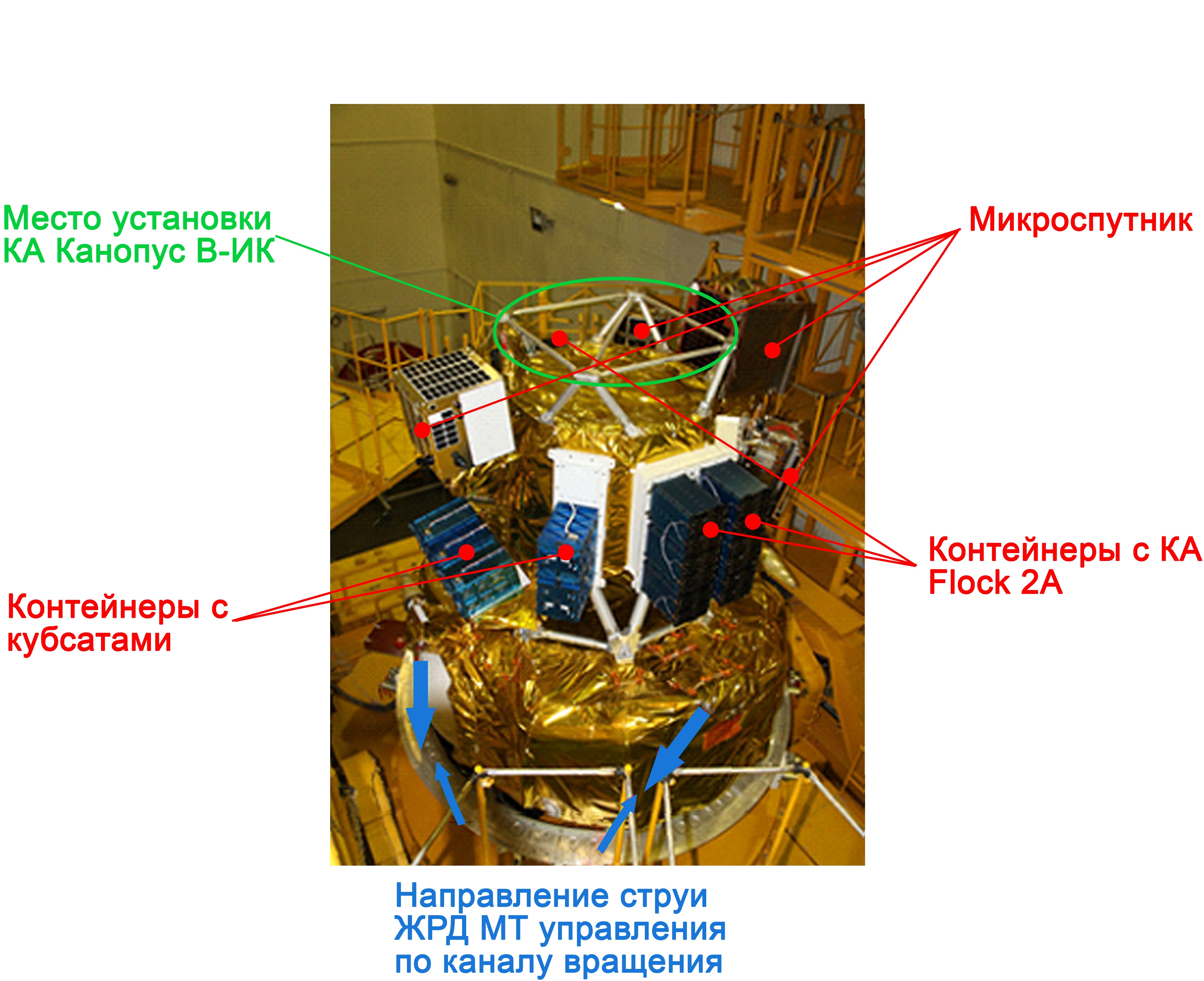
Explanations for the photo from the page www.roscosmos.ru/23733
It can be seen that the axes of the nozzle rocket engines used for control along the rotation channel pass close to the containers with cubes. At the same time, the Kanopus-V-IK satellite and the Flying Laptop, TechnoSat, WNISAT-1R, NORSAT-1, and NORSAT-2 microsatellites are significantly farther from the LRE MT than containers with cubesets. This suggests that some of the decomposition products of hydrazine could get onto the cube containers without damaging the “Canopus-V-IC” and microsatellites located farther from the LPRE MT nozzles.
The degree of probability of this type of accident should also be recognized as low, since even when it hit the outer parts of the containers, the decomposition products of hydrazine with a small degree of probability could damage the censors inside the containers. Nevertheless, in the future we will consider this version in more detail.
6. Damage to the jet stream during normal operation of the sustainer liquid-
propellant rocket engine. The sustained-motion C5.92 liquid-propellant rocket engine with a turbo-pump supply of the AT and UDMG components is located on the opposite side of the accelerating unit relative to the payload and emits combustion products to the side opposite to the payload. It practically excludes hit of products of combustion on payload. In addition, this engine is not duplicated and, therefore, if it fails, the upper stage will lose the ability to perform maneuvers to change the parameters of the orbit.

Thus, this type of accident can be considered unlikely and excluded from further consideration.
7. Damage to hydrazine and its decomposition products during abnormal operation of the propulsion system of the reactive control system.
Consider, in principle, the possibility of complete or partial failure of the propulsion system of the reactive control system and its coordination with known facts.
The complete failure of all LRE MTs is inconsistent with the well-known facts in the sense that after the separation of 19 cubic meters the Frigate built the orientation to turn on the cruise engine and supported it in the process of maneuver. That is, if the failure took place, then only a partial failure.
What failure could potentially damage the Cubsat, but at the same time would not deprive the Frigate of the opportunity to build and maintain the required orientation?
Consider the scheme of the propulsion system of the reactive control system, given in the Bulletin of the NPO. Lavochkin, №1 from 2014 [ 11 ].

The rocket engine MT in this scheme is designated as DV1-DV4, DR9-DR12 and DT5-DT8, a total of 12 pieces.
The physical location of the LRE MT on the “Frigate” is shown in the figures above. Analyzing the location of the nozzles and their orientation, we can conclude that the failure of any two LREs from the groups, one of DV1-DV4 and one of DR9-DR12, DT5-DT8, does not say hello to the loss by the upper stage of the ability to build and maintain orientation.
Consider the possible types of failures LRE MT. For this we use its scheme from the source [ 11 ].
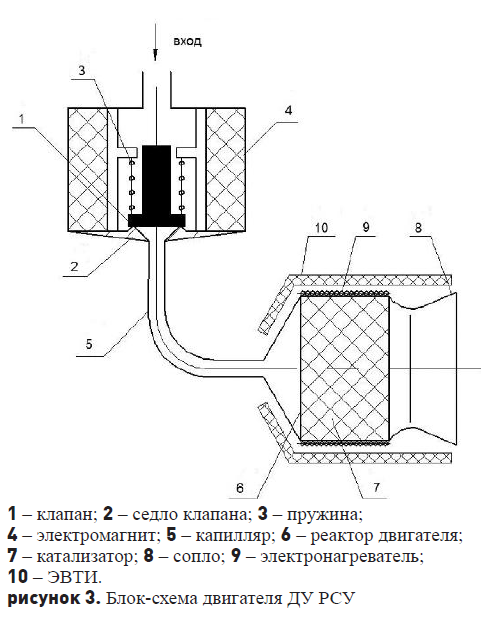
Possible types of failures of a single engine
- engine valve does not open fully at the command of the control system,
- engine valve does not close completely at the command of the control system,
- the electric heater does not turn on at full power at the command of the control system,
- the electric heater does not turn off completely at the command of the control system,
- hydrazine leakage from the fuel lines between the tank and the engine,
- blockage of the highway or engine by foreign particles.
Analysis of the types of failures leads to the conclusion that they fall into two groups:
- hydrazine and / or its decomposition products do not enter the environment,
- hydrazine and / or its decomposition products enter the environment,
In the first case, pollution and damage to the cubs does not occur, in the second - occurs. In the case of this type of failure, in which hydrazine enters the external environment during the separation of cube-caps, their external surfaces, including photoelectric converters, may be contaminated, as well as hydrazine and its decomposition products entering the interior of the apparatus.
Therefore, this type of accident needs to be considered in more detail. Moreover, the ingress of hydrazine decomposition products to cubes is also not excluded during the normal operation of the LRE MT.
8. Damage to asymmetric dimethylhydrazine and its decomposition products during abnormal operation of the marching propulsion system.
This type of accident can be considered unlikely on the grounds that after the separation of the Kubsat in orbit with a conditional apogee of 600 km, the upper stage made at least two more successful inclusions of the marching propulsion system — for descent into orbit with a conditional apogee of 475 km and for de-orbit. . This suggests that the work of the marching propulsion system proceeded normally and this failure in its operation was absent.
9. Damage to nitric tetroxide and its decomposition products due to abnormal operation of the cruise propulsion system.
On the same grounds as the previous one, this type of accident can be considered unlikely and excluded from further consideration.
10. Damage caused by radiant heat flux from a running low-thrust liquid propellant rocket engine
According to the document by Soyuz User's manual [ 9 ], during normal operation, the thermal effect of any LRE on the spacecraft is excluded. Therefore, this type of accident can be considered unlikely and excluded from further consideration.
11. Damage caused by radiant heat flux from a working cruise fluid rocket engine
Due to the fact that the sustainer liquid-propellant rocket engine is located on the side of the accelerating unit opposite to the payload, and also taking into account that the regular liquid-propellant rocket engine is off during normal flight during the separation of the spacecraft from the accelerating unit, this type of accident can be considered unlikely. At the same time, no signs of abnormal operation of the main engine were found, which makes it possible to further reduce the likelihood of this type of accident and exclude it from further consideration.
12. Damage due to the increased level of electromagnetic radiation emitted by the antennas of the accelerating unit.
According to the Bulletin of the NPO im. Lavochkina, №1 from 2014 [ 11] aboard the Frigate, radio transmitters with frequencies of 625-639 MHz and 2200-2290 MHz are installed. According to Brian Klofas, given in the CubeSat Communication Systems: 2003–2017 [ 13 ] table, among the failed cubes there were no devices operating at these frequencies. Consequently, even with an elevated relative to the normal level of electromagnetic radiation from the Frigate antennas, damage to the Kubsat receivers can be considered an unlikely event. In addition, this type of accident does not explain the “delayed” failure of a part of satellites and signals from them about low battery power. Therefore, this type of accident can be considered unlikely and excluded from further consideration.
Detailed analysis of the likely failure options
Contact with hydrazine and its decomposition products on cubesat
In the two types of failure considered, in the case of normal and abnormal operation of the propulsion system of the reactive control system, the entry of hydrazine and its decomposition products onto the cubs sets is not excluded. Let us consider this process in more detail, and also describe a possible mechanism for damage to the onboard equipment of satellites by the products of hydrazine decomposition.
In the case of regular operation of the LRE MT, the decomposition products of hydrazine are expanding at high speed from the “Frigate” and satellites, while only a small part of the exhaust has a chance to settle on the external structural elements of the upper stage and its payload.
In the event of abnormal operation of the LPRE MT, the following options for the development of the situation are possible:
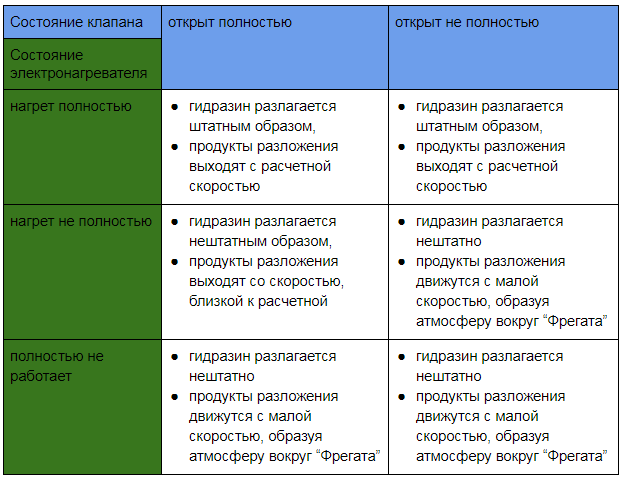
According to Bolshakov’s reference book “Chemistry and Technology of Liquid Rocket Fuel Components” [14], hydrazine is decomposed by ultraviolet light with a wavelength of 253.7 nm or less into ammonia, nitrogen and hydrogen, forming in the intermediate stages chemically active free radicals of the form NH, NH2, H. These chemical compounds are capable of reacting with materials of on-board satellite equipment. In addition, according to the reference book [12], the ammonia itself also causes corrosion of copper and its alloys.
Conclusions from the analysis of external causes of failure
The considered events with could lead to the following consequences:
- contamination of the external surfaces of solar cells with the products of the reaction of free radicals formed by the photochemical decomposition of hydrazine and materials of solar cells;
- , , ;
- , , .
These consequences coincide well with the known facts about the status of spacecraft injected into orbit with an approximate apogee of 600 km, which demonstrated either a complete failure without access to a communication session, or transmitted telemetry about a low level of onboard batteries before a complete failure.
Apparently, a complete failure without a connection to the session is explained by the large number of breaks in the electrical circuits in the electrical connectors and / or onboard equipment. The low level of charge of onboard batteries can be explained by a decrease in the efficiency of conversion of solar radiation into electrical energy due to contamination of the external, illuminated surface of photoelectric converters of solar batteries, and thereby reducing the generation of electrical energy.
Forecasts based on hypotheses
The described damage mechanism makes it possible to predict the further development of the situation with spacecraft launched into orbit with an approximate apogee of 600 km.
- There may be new announcements of non-switched or failed cubesats immediately after launch, and the declared refusal should have the same signs as those already announced - either full from the very beginning, or partial with transmission before full failure of the telemetric information on low battery level .
- There may be announcements about the change in the design of the RB “Fregat” or the LRE MT used on it.
The following scenarios are less likely, but possible.
- Publication of telemetry data from the “Frigate”, indicating the failure of one or two LPRE MT.
- Publication of the report of the emergency commission on the analysis of the causes of the accident of the Kubsat in the launch on July 14, 2017, which contains the reason for the refusal described in this document.
Conclusion
Thus, according to our assumptions given in this study, a possible cause of the failure of “Mayak” and its nine companions may be the ingress of decomposition products of hydrazine from the LRE MT of the Fregat accelerating unit. The decomposition products entered into a chemical reaction with the structural materials of photovoltaic cells of solar cells, causing their pollution, and with the structural materials of the onboard equipment, causing their corrosion.
Special opinion. The developer of the power supply system Anton Alexandrov said:
“Despite the fact that we were not able to establish the internal cause of Mayak’s refusal, I would consider the possibility of the influence of external factors as the last thing. Nevertheless, we are a young and inexperienced team of satellite builders, and in the apparatus itself “civilian” components are used, albeit the best and proven ones. And, although some of us have experience in designing space technology, and the mastodons of the industry helped us, I believe that the greatest probability of the cause of failure is internal. Defects of soldering or wiring, explosion or marriage of only two adjacent cells of the battery, sticking of the container casements, failure of roulette motors, sticking of limit switches - any of these problems would be enough for our satellite not to work. Yes, we have carried out the tests to the maximum both before launch and after the failure - but the fact that we did not find an internal reason, in the first place,reason to look for it further. "
- www.space-track.org/#/catalog .
- spacenews.com/additional-cubesats-on-july-14-soyuz-flight-are-unresponsive
- www.vniiem.ru/ru/index.php?option=com_content&view=article&id=814 :-lr&catid=36:2008-03-09-13-50-48&Itemid=50
- www.kleinsatelliten.de/news/Launch_and_Early_Operations_Phase_of_the_Flying_Laptop_is_Complete/?__locale=en
- www.raumfahrttechnik.tu-berlin.de/zielgruppen/events_announcements/news/parameter/en
- translate.google.com/translate?sl=ja&tl=ru&js=y&prev=_t&hl=ru&ie=UTF-8&u=https%3A%2F%2Fwww.axelspace.com%2Finfo%2Fnews%2F20170718%2F20170718_release%2F&edit-text=&act=url
- www.utias-sfl.net/?p=2663
- spacenews.com/glavkosmos-denies-launch-vehicle-caused-cubesat-failures
- www.arianespace.com/wp-content/uploads/2015/09/Soyuz-Users-Manual-March-2012.pdf
- directory.eoportal.org/web/eoportal/satellite-missions/c-missions/cubesat-concept
- vestnik.laspace.ru/archives/01-2014
- . . / . . , . . . — : , 1975.
- www.klofas.com/comm-table/table.pdf
- . . . ., 1983.
Source: https://habr.com/ru/post/374041/
All Articles